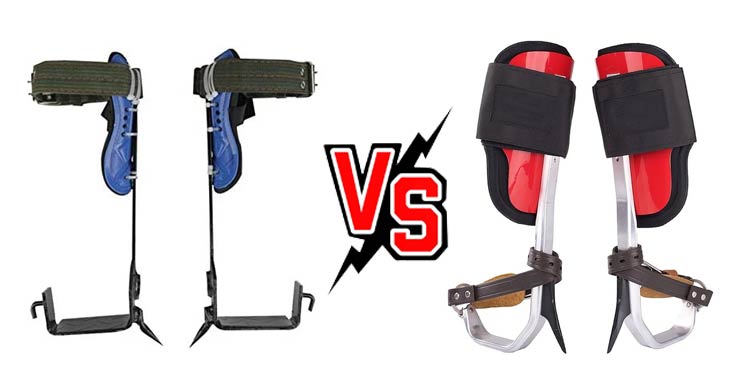Whether you love to climb trees or cut trees down for a profession, there is one question, should you purchase a pole spike or tree spike?
First, you need to understand the functioning and purpose of both tools. That way, you will be able to decide which one would be better suited for the task you have in mind.
Alright! Pole spike vs tree spike. Traditionally, the main difference between the two spikes is that tree climbing spikes are mainly used for working with the softwoods and hardwood of thick barks, while the pole spike is primarily used for working on the hardwood of thin bark and flat angles.
As we begin to explore the details of the two devices, we will begin to understand which would be the preference for a variety of scenarios.
Pole Spikes vs. Tree Spikes – What’s the Difference?
Tree Spikes
To begin our exploration of the two, first up are tree spikes. As mentioned earlier, tree spikes are used primarily for working with thick barks.
Tree spikes are a must-have if anyone plans on climbing trees anytime soon. These spikes are typically used for the purposes of cutting down or removing plants or trees.
Gardeners, carpenters, and hunters are among the names of people who use these specific spikes most of the time.
A package of spikes usually comes with safety straps and metal spikes to help cut trees with ease and caution.
Typically, the spikes themselves, or spurs, are manufactured from either steel, carbon, alloy, or titanium, all very strong substances.
Knowing this, customers tend to steer towards the steel spikes for heavier projects, so just keep that in mind.
A more affordable route would be the titanium and alloy spikes. These are typically cheaper than steel while remaining lightweight and comfortable.
Reiterating, tree spikes are best useful for situations dealing with hardwood with thick bark and softwood trees.
These spikes provide the user with high-heeled angles that could be very beneficial in certain circumstances.
Also, remember to keep in mind that when choosing your tree spikes, the material does matter!
Whether or not you choose to use steel or alloy is all going to be up to the goal you are trying to accomplish.
Steel, by far, has proven to be the most durable over time but not necessarily the most economical.
Pole Spikes
The next part of the exploration takes us to pole spikes. Pole spikes, unlike tree spikes, are primarily used for, you guessed it, poles.
These spikes are supposed to help reduce the risk of hurting oneself while cutting or peeling poles.
This does not mean that pole spikes can not be used in place of tree spikes. This does not mean it is right to do so either, just a fact. Leather pole spikes are the most durable of the bunch.
Typically, pole spikes come with an inner cushion padding system that helps when one is trying to rest his or her legs.
The pricing for pole spikes ranges from affordable to expensive, much like tree spikes.
Reinstating pole spikes are better for thin-barked trees. Also, they are more robust and more durable than tree spikes when it comes to flat angles.
So a part of the decision-making process would be to decide whether or not you are going to be working with flat angles primarily or not.
All in all, pole spikes and tree spikes are very similar yet different. Review the table below:
|
Tree Spikes |
Pole Spikes |
|---|---|
| 1. Can be used for hardwood trees | 1. Can be used for hardwood trees |
| 2. Used for the hardwood that is thick-barked or softwood trees | 2. Used for poles or thin-barked trees, |
| 3. Not recommended using on poles | 3. Safer when being used to climb poles |
| 4. Less strong and durable | 4. More strong and durable |
| 5. Higher heel angles | 5. Uses flat angles |
Read More:
Conclusion
In conclusion, the hope is that you now have a better understanding of the differences and similarities between tree spikes and pole spikes.
Although these two devices are very similar, they differ in a few very important ways. First off, tree spikes are typically going to be used for any work dealing with thick-barked trees, not poles.
The higher heel angles and designed for climbing huge trees.
On the other end, pole spikes are primarily used for poles and flat angles. Yes, you can use these spikes to climb trees as well but that is not their primary function.
Knowing this, the best way to narrow down which spikes would best suit you would be to analyze the project you need the spikes for.

